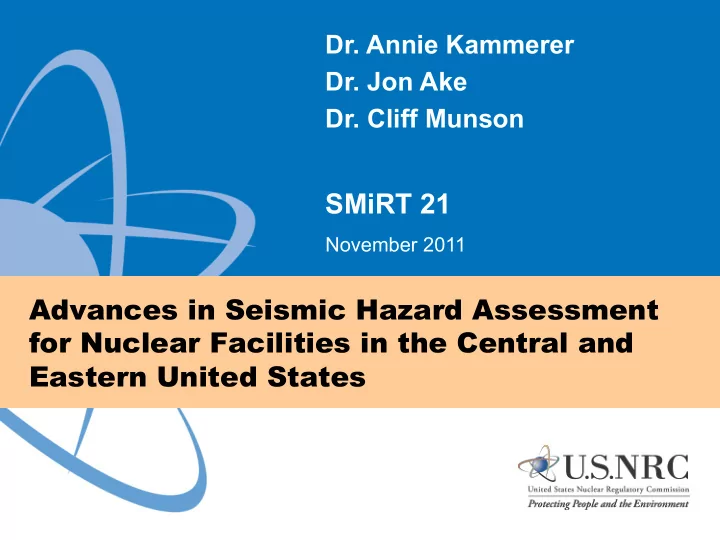

Dr. Annie Kammerer Dr. Jon Ake Dr. Cliff Munson SMiRT 21 November 2011 Advances in Seismic Hazard Assessment for Nuclear Facilities in the Central and Eastern United States
Central and Eastern US Seismic Source Source Characterization project for Characterization Nuclear Facilities (CEUS SSC) Ground motion Next Generation Attenuation prediction equations Relationships for the Central and Eastern (NGA-East) Recommendations for Application Framework for large of the SSHAC Guidelines PSHA studies 3 projects that work together
PSHA CEUS Seismic Source Characterization Project for Nuclear Facilities (SSC) Rieter, 1991 NGA-East (Ground Motion Characterization) n ∞ M max E ( PGA ) f ( M ). f ( r ). P ( PGA PGA M , r ) dr . dM = α > ∑ ∫ ∫ i i i M min i 1 r = min
CEUS SSC Project • Central and Eastern United States Seismic Source Characterization for Nuclear Facilities Project • 4 Year SSHAC Level 3 project to create new source model for the CEUS • Model finalized and accepted by the PPRP • NRC GI-199 draft letter notes CEUS SSC models as accepted model for reevaluation
CEUS SSC Project • Publically available in January as an NRC NUREG, EPRI report, and DOE report • Web site to be published in February 5
CEUS SSC Project • Regional model used as a starting point for all reactors in the study area • Applicants perform a SSHAC Level 2 refinement to the model as per RG1.208. 6
• Appropriate data collection and field investigation efforts to meet 10 CFR 100.23 requirements Increasing level of Site (>1km) effort close to site. However, any seismic Site Area (>8 km) sources that may impact hazard should Site Vicinity (>40 km) be appropriately assessed. Regional source Site Region (>320 km) models ( e.g. new CEUS SSC model ) must still be refined with site-specific information Data Collection in RG1.208
CEUS SSC Advancements Source USGS Li et al, 1998 • Identification of zones of “Repeated Large Magnitude Events”, principally through advanced paleoseismicity techniques • State-of-the-art Bayesian Mmax assessments 8
CEUS SSC Advancements • New fully consistent seismicity catalog, with transparent tracked and documented uncertainties in all conversions • A new approach to variable a- and b-values using a “Penalized Likelihood” approach • Comprehensive GIS database combining all available datasets • New Paleoliquefaction Database and new description of associated “best practice” 9
CEUS SSC Advancements • New “Data Evaluation” and “Data Summary” tables to document and summarize all available data, models and methods, and their use in the model – Example provided in the SSHAC NUREG – Modified for use in the NGA-East and South Africa SSHAC Level 3 projects 10
NGA-East • Next Generation Attenuation Relationships for Central and Eastern North America (participation of Canada & other countries in stable continental regions (SCR)) • SSHAC Level 3 project to be complete 2014 • Managed and led by the Pacific Earthquake Engineering Research Center at University of California, Berkeley
NGA-East • Extremely complex study requiring a large amount of research and development • Global SCR database being collected and beneficial research for SCRs globally • New work in geotechnics, source inversion, and a large number of simulations to complement limited earthquake database • Data from August 2011 Mineral Virginia earthquake to be collected
NGA-East
NGA-East Simplified Flow Chart of Activities
NGA-East Complete Flow Chart of Activities
• Complete project plan, videos and presentations from past workshops, and other documentation available on-line • http://peer.berkeley.edu/ngaeast/
SSHAC Guidelines • Refer to Presentation on Paper 699 • NUREG supplements NUREG/CR-6372 • NUREG in final publication • Use of SSHAC guidelines in applications for new reactors in the US – New Level 3 regional model to be used for new reactors in the east through CEUS SSC and NGA-East projects. – New reactors in the west must perform a site-specific Level 3 or 4 assessment study due to lack of a regional model 17
Fukushima Lessons Fukushima Learned Report with Lessons Learned Recommendations for Report with changing NRC Significant regulations and practices Recommendations for changing NRC Recommendation 2.1 Order regulations and licensees to reevaluate the seismic practices and flooding hazards at their sates against current NRC requirements and guidance, and if necessary update the design basis and SSCs important to safety to protect against the updated hazards NRC NRC ML111861807 ML111861807 18
SSHAC Guidelines • Re-evaluation of Operating Reactors – Generic Issue 199 draft letter out for comment (ML111710782) merging with NTTF R2.1 – Existing reactors in the will use the new CEUS SSC model with the 2004, 2006 EPRI ground motion prediction equations – Existing reactors outside of the CEUS SSC study region will be required to perform site- specific SSHAC Level 3 studies. (Diablo Canyon PP is staring this month) 19
SSHAC Guidelines • For NPPs in the United States – 2 Ongoing cooperative regional SSHAC Level 3 studies (one complete in December) – 1 SSHAC Level 3 study for a new western site starting imminently – 1 SSHAC Level 3 study for an existing western site starting imminently – 3 additional SSHAC Level 3 or 4 studies for operating NPPs are expected for GI-199 20
Thank You Advances in Seismic Hazard Assessment for Nuclear Facilities in the Central and Title Goes Here Eastern United States
Recommend
More recommend